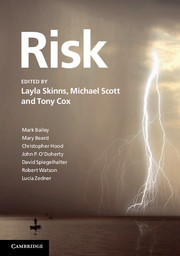Book contents
- Frontmatter
- Contents
- Figures
- Tables
- Acknowledgements
- 1 Introduction
- 2 Quantifying uncertainty
- 3 Decisions, risk and the brain
- 4 Risk and government
- 5 Risk and the humanities
- 6 Terrorism and counterterrorism
- 7 Risk and natural catastrophes
- 8 Risk in the context of (human-induced) climate change
- Notes on the contributors
- Index
- References
2 - Quantifying uncertainty
Published online by Cambridge University Press: 05 June 2012
- Frontmatter
- Contents
- Figures
- Tables
- Acknowledgements
- 1 Introduction
- 2 Quantifying uncertainty
- 3 Decisions, risk and the brain
- 4 Risk and government
- 5 Risk and the humanities
- 6 Terrorism and counterterrorism
- 7 Risk and natural catastrophes
- 8 Risk in the context of (human-induced) climate change
- Notes on the contributors
- Index
- References
Summary
Putting numbers on risks
Risk is a strange concept. Different disciplines have tried to define it precisely, but perhaps it is better to be informal and follow more popular usage. I shall take it as anything to do with situations where ‘bad’ (or ‘good’) things may, or may not, happen. The crucial elements are that there is uncertainty, and that the outcomes may be nice or nasty.
A wealth of recent psychological research has shown that we mainly use ‘gut feelings’ to deal with such situations, rather than carefully weighing up the consequences and assessing numerical probabilities, as more formal approaches would have us do. Our feelings are influenced by culture, our experiences and those of people close to us, media coverage, emotional feelings of dread, or hope, and so on, but we manage to get by most of the time, and it is noticeable how recently, in historical terms, the theory combining probability and ‘rational’ decision-making was developed. Even when evidence is available about the ‘size’ of a risk, in sufficiently stressful situations it may be ignored. Cass Sunstein, a senior adviser to Barack Obama, claims that people display ‘probability neglect’ when confronted with vivid images of terrorism, so that ‘when their emotions are intensely engaged, people's attention is focused on the bad outcome itself, and they are inattentive to the fact that it is unlikely to occur’. So the ‘true’ risks are ignored; it's been shown that people are, rather illogically, willing to pay more for insurance against terrorism than insurance against all risks (which implicitly include terrorism), just because the use of the word conjures up dread.
- Type
- Chapter
- Information
- Risk , pp. 17 - 33Publisher: Cambridge University PressPrint publication year: 2011
References
- 5
- Cited by



